In the world of interior design, trends come and go, but some styles stand the test of time with their timeless appeal and enduring aesthetics. Mid-century modern design is one such trend that has seen a resurgent popularity, especially in kitchen interiors. Originating in the mid-20th century, this design style is renowned for its clean lines, minimalist approach, and a strong emphasis on functionality.
This blog post is designed to inspire homeowners and design enthusiasts who are looking to infuse their kitchens with the elegance and simplicity of mid-century modern design. From the iconic color palettes to the sleek cabinetry and furniture that define this era, we will explore various facets of this design style. We will delve into the historical context, discuss the essential elements like materials and layouts, and even draw inspiration from real-life transformation cases.
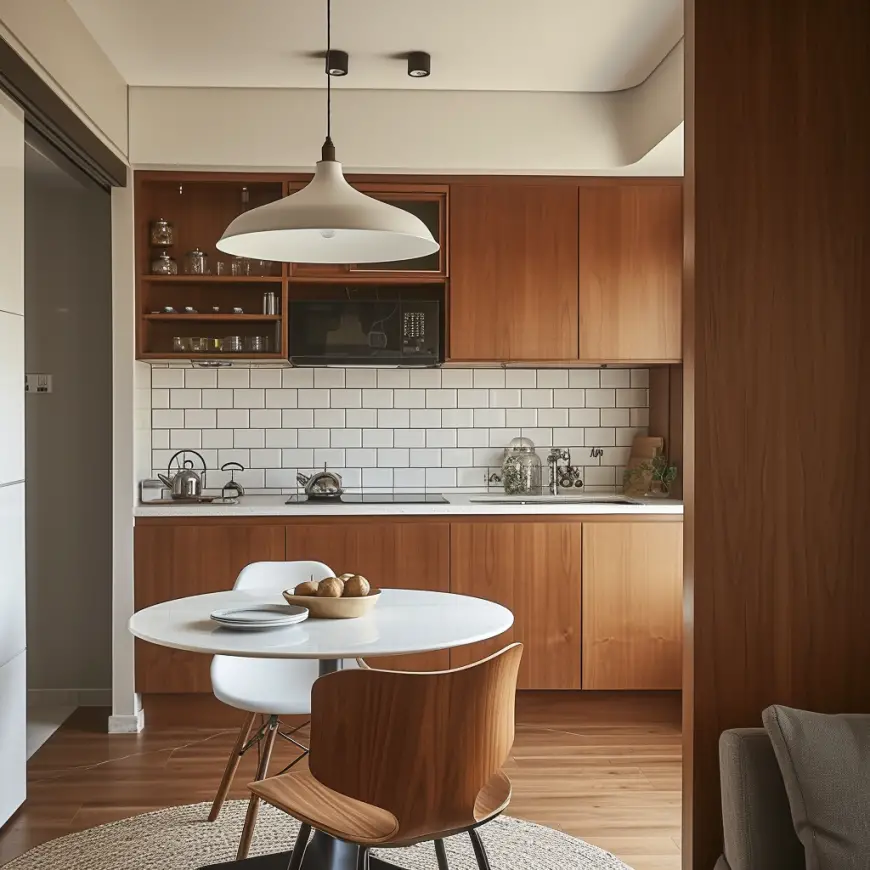
Whether you are planning a complete kitchen overhaul or just looking to add a touch of mid-century charm, this guide will provide valuable insights and creative ideas from an interior designer’s perspective. Get ready to embark on a journey through time, bringing a classic yet contemporary flair to your kitchen space.
Historical Context of Mid-Century Modern Design
The Roots and Rise of a Design Revolution
Mid-century modern design, a term that encapsulates a style period from roughly the mid-1930s to the mid-1960s, marked a defining era in architecture and interior design. Its roots can be traced back to the International and Bauhaus movements, with pioneers like Walter Gropius and Le Corbusier laying the foundational principles of simplicity and functionality.
Post-War Influence and Kitchen Evolution
The end of World War II brought about significant changes in American society, including in the realm of interior design. There was a shift towards optimism, functionality, and a break from the past. This period saw the kitchen transforming from a purely utilitarian space into a heart of the home, influenced significantly by technological advancements and a growing emphasis on family life.
Iconic Designers and Their Legacy in Kitchen Design
Designers such as Charles and Ray Eames, Eero Saarinen, and George Nelson became household names, each contributing to the distinctive aesthetic of the era. Their designs were characterized by clean lines, organic forms, and a seamless blend of different materials. In kitchen design, this translated to efficient layouts, modular cabinets, and a blend of natural and man-made materials, setting the stage for modern kitchen designs we see today.
The mid-century modern design philosophy centered around the idea that form should follow function, a concept vividly evident in kitchen designs from this era. The efficient use of space, integrated appliances, and minimal ornamentation were not just aesthetic choices but reflections of a broader cultural movement towards simplicity and practicality.
The Essence of Color in Mid-Century Kitchen Design
Vibrant Palettes: A Signature of the Era
Mid-century modern design is well-known for its unique and vibrant color schemes. Unlike the subdued and neutral palettes often seen in contemporary designs, mid-century kitchens embraced bold and saturated hues. This was a period where colors were used to make a statement, reflecting a post-war era filled with optimism and a desire for change.
Popular Color Choices and Combinations
Characteristic colors of this era include mustard yellow, avocado green, teal, orange, and shades of brown and gray. These colors were often paired in dynamic combinations to create visually stimulating spaces. For instance, a kitchen with teal cabinetry might feature mustard yellow accents, blending retro charm with modern sensibilities.
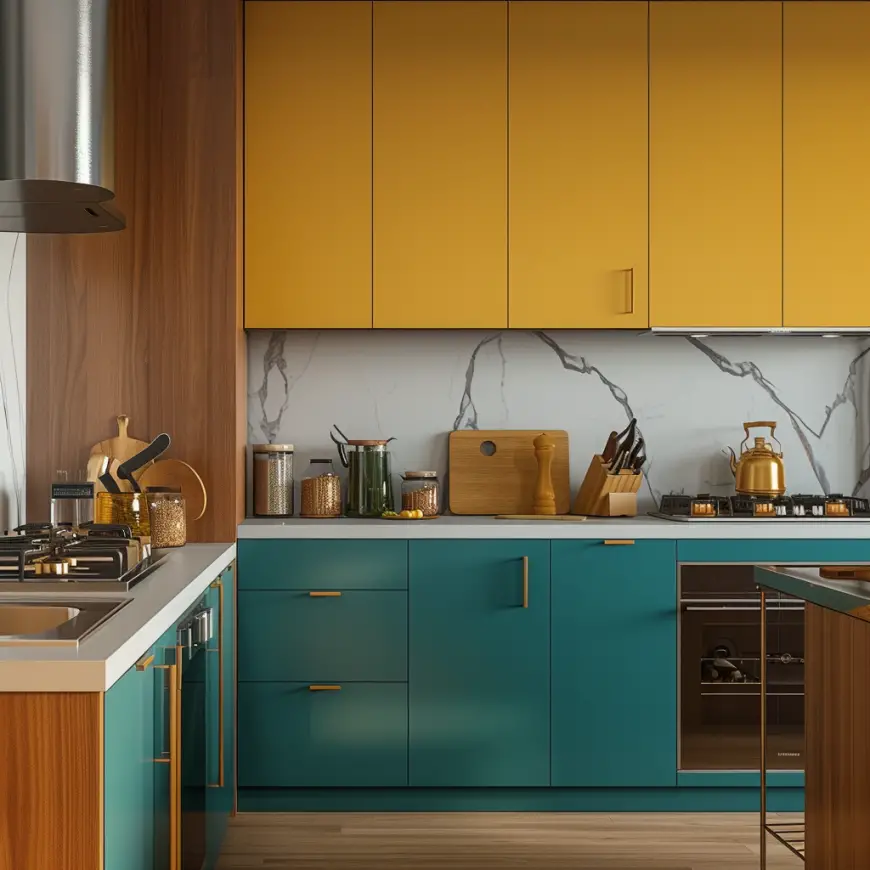
The use of such bold colors was not just a stylistic choice but also a reflection of the era’s technological advancements in paint and material production. These developments allowed for a broader range of colors and finishes in kitchen designs, something that had not been possible before.
Strategies for Implementing Mid-Century Colors
Incorporating these colors into a modern kitchen can be done in several ways. One approach is to use bold colors on cabinetry or as an accent wall, balanced with neutral tones elsewhere to avoid overwhelming the space. Alternatively, smaller pops of color can be introduced through backsplashes, appliances, and accessories, offering a nod to the mid-century aesthetic without overpowering the contemporary design elements.
Another critical aspect of color usage in mid-century design is the integration of natural wood tones. The warmth of wood, often in teak, walnut, or oak, provides a perfect counterbalance to the vibrant hues, adding a sense of harmony and earthiness to the kitchen space.
Psychological Impact of Color Choices
The psychological impact of color was also a consideration in mid-century design. Warmer tones often create a welcoming and energetic atmosphere, ideal for spaces like the kitchen where people gather and socialize. Understanding this aspect can be crucial for homeowners and designers looking to recreate the mid-century ambiance in a functional and aesthetically pleasing manner.
Selecting the Right Materials and Cabinets
Embracing a Mix of Materials
One of the hallmarks of mid-century modern kitchen design is the innovative use of materials. This era witnessed a blend of traditional materials like wood with newer, man-made materials like laminate, metal, and glass. This juxtaposition not only added visual interest but also reflected the technological advancements of the time.
Wood: The Timeless Choice
Wood was a predominant material in mid-century kitchens, with teak, walnut, and oak being particularly popular. These woods were often used in their natural form, showcasing their grain and texture, which added warmth and organic beauty to the kitchen space. The use of wood extended beyond cabinetry to include paneling, flooring, and even ceiling beams, creating a cohesive and inviting environment.
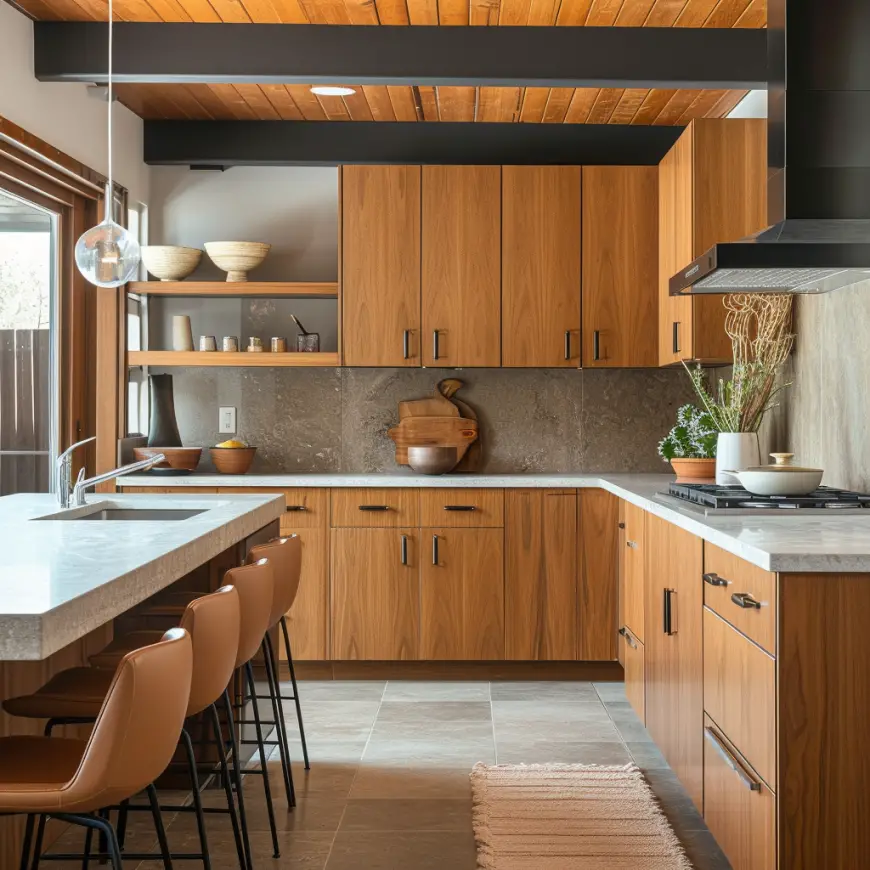
Innovative Use of Laminate and Metal
Laminate was another revolutionary material of this era. Durable, affordable, and available in a variety of colors and patterns, it became a popular choice for countertops and cabinet fronts. Its ease of maintenance and ability to mimic higher-end materials made it a practical yet stylish option.
Metal also found its way into mid-century kitchens, not just in appliances but in cabinetry hardware, light fixtures, and as accents. Stainless steel and chrome were particularly favored for their sleek look and durability, complementing the clean lines of the cabinetry.
Characteristics of Mid-Century Modern Cabinets
Mid-century modern kitchen cabinets are distinguished by their sleek, unadorned lines, flat surfaces, and minimal hardware. This simplicity and focus on horizontal lines emphasize the feeling of space and openness in the kitchen. The cabinetry often features a combination of open shelving and closed units, offering both display space and hidden storage.
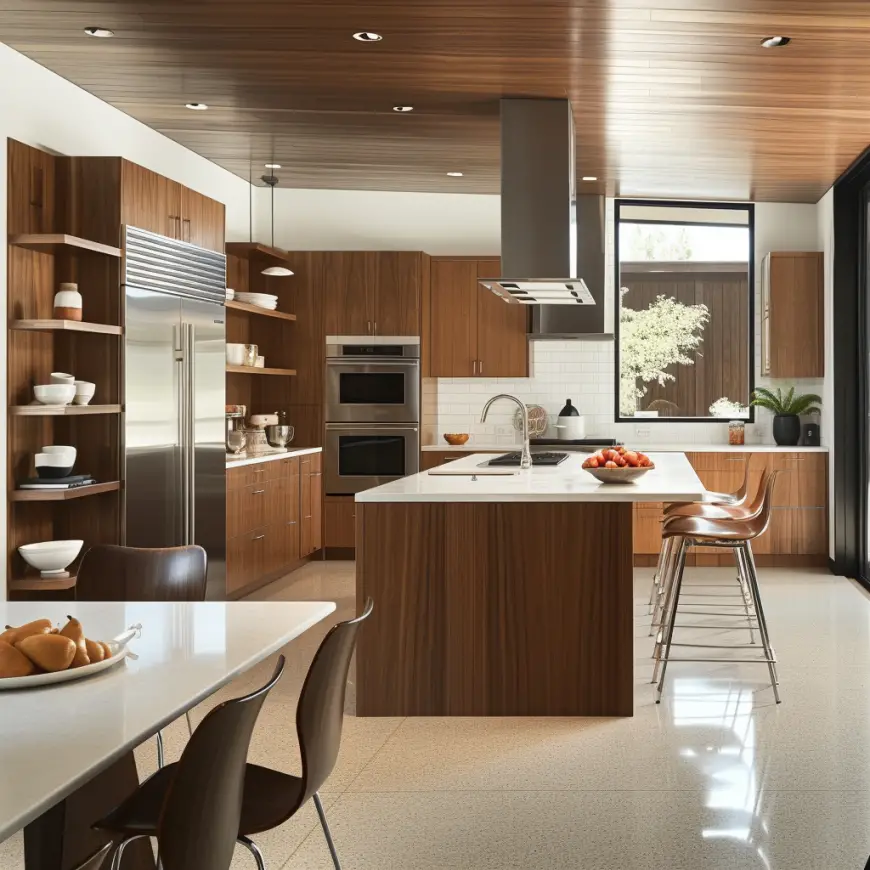
Tips for Material and Cabinet Selection
When selecting materials and cabinets for a mid-century kitchen, consider the balance between form and function. Opt for clean lines and flat-panel doors for cabinets. Choose materials that are not only aesthetically pleasing but also practical for kitchen use. Incorporating a mix of natural and man-made materials can create an authentic mid-century feel while ensuring durability and ease of maintenance.
Furniture Choices: Focus on Kitchen Tables and Backsplashes
The Central Role of Kitchen Tables
In mid-century modern kitchen design, the kitchen table is not just a piece of furniture; it’s a focal point. These tables typically embody the era’s design ethos — functional, simple, and often featuring organic shapes like round or oval tops. Materials like wood, glass, and Formica were popular, often paired with metal legs for a sleek, industrial look.
The choice of a kitchen table in this style often depends on the space’s size and layout. In smaller kitchens, a compact, round table can create a sense of openness, while larger spaces can accommodate an oval or rectangular table, providing ample space for family gatherings.
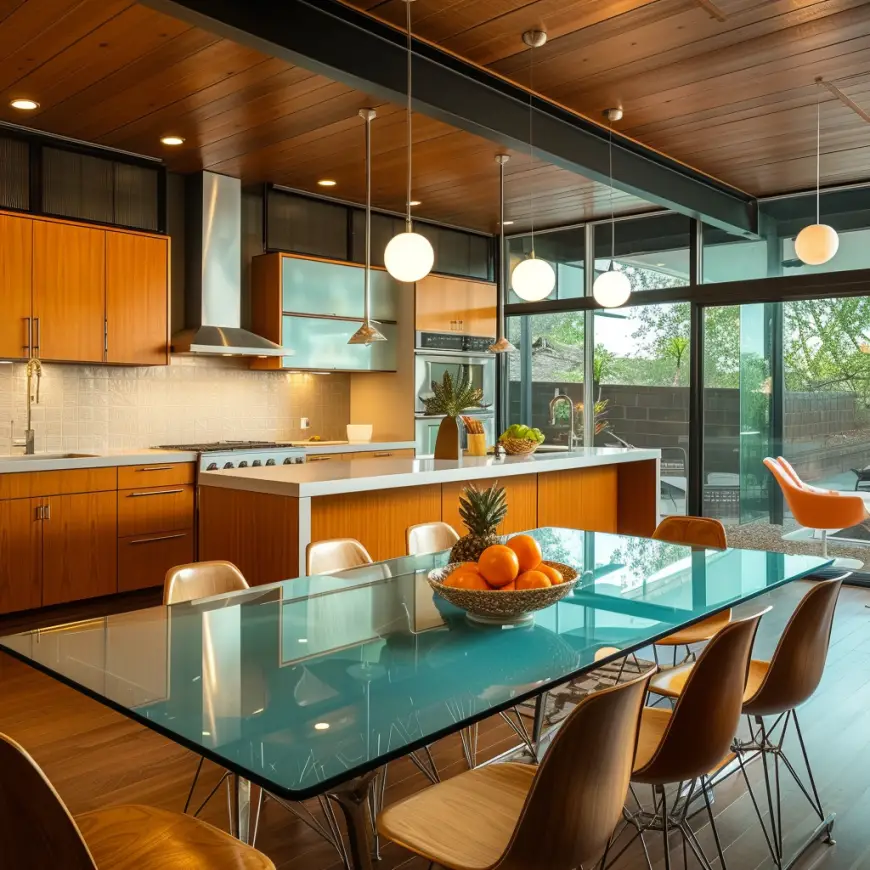
Design Options for Backsplashes
Backsplashes are another element where mid-century modern design shines. In the mid-20th century, backsplashes served both a functional and aesthetic purpose, protecting walls from splashes while adding a design element to the kitchen.
Tiles were a popular choice, with colorful, geometric patterns or simple, monochromatic designs. Subway tiles, either in traditional white or bold colors, were also widely used, often laid in unique patterns to add visual interest. The use of glass or metallic tiles can add a modern twist to this vintage style, reflecting light and making the space feel brighter and larger.
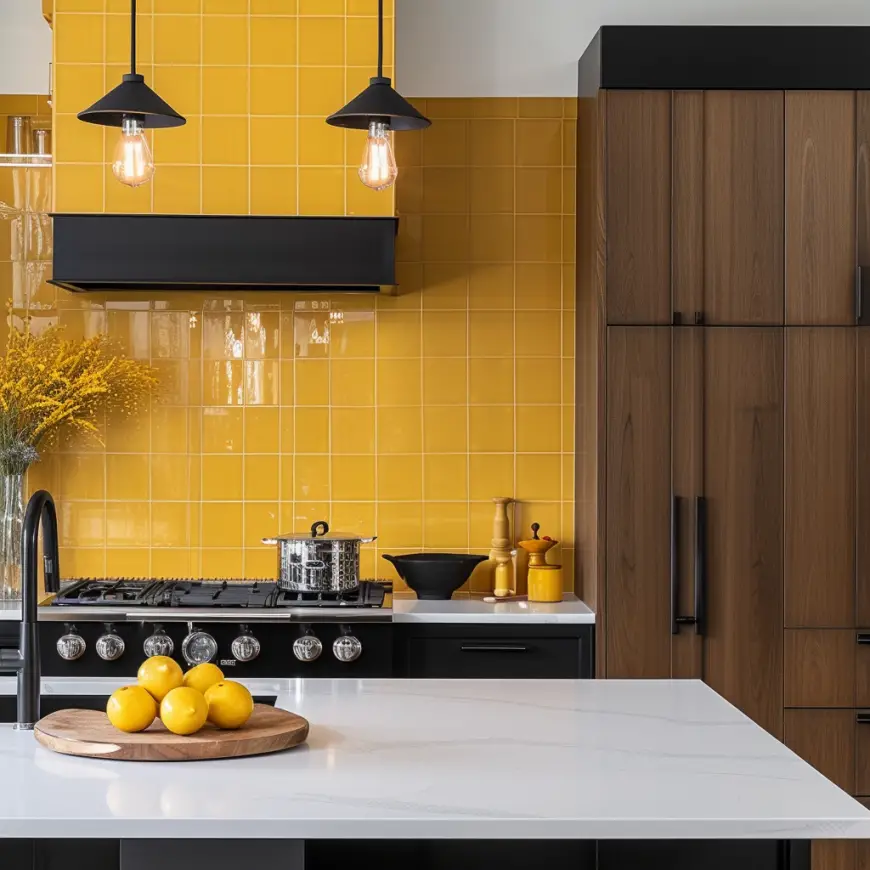
Integrating Furniture with Overall Kitchen Design
When integrating furniture like tables and backsplashes into a mid-century kitchen, it’s essential to maintain a balance between form and function. The table should complement the kitchen’s color scheme and materials, creating a cohesive look. Similarly, the backsplash, while potentially a statement piece, should not clash with the kitchen’s overall design.
Selecting a kitchen table and designing a backsplash provides an opportunity to inject personal style into the space. Whether opting for a vintage piece or a modern interpretation of mid-century design, these elements can significantly impact the kitchen’s overall feel.
Concepts and Layouts for the Ideal Mid-Century Kitchen: Embracing Minimalism and Functionality
The mid-century modern design ethos revolves around the principles of minimalism and functionality. Kitchens designed in this style are marked by their clutter-free, streamlined appearances, where every element serves a purpose. This approach not only creates a visually appealing space but also enhances the kitchen’s usability.
Key Design Concepts
- Minimalism: This is evident in the clean lines, uncluttered surfaces, and lack of ornate detailing. The focus is on creating a space that is easy to navigate and use.
- Functionality: The layout and design elements are chosen for their practicality. This includes thoughtful placement of appliances, efficient storage solutions, and adequate counter space.
- Integration of Indoor and Outdoor Spaces: Mid-century modern homes often feature large windows and open floor plans that blur the lines between indoor and outdoor spaces. This concept can be incorporated into kitchen design through the use of natural light and materials, and by ensuring a visual connection to outdoor spaces.
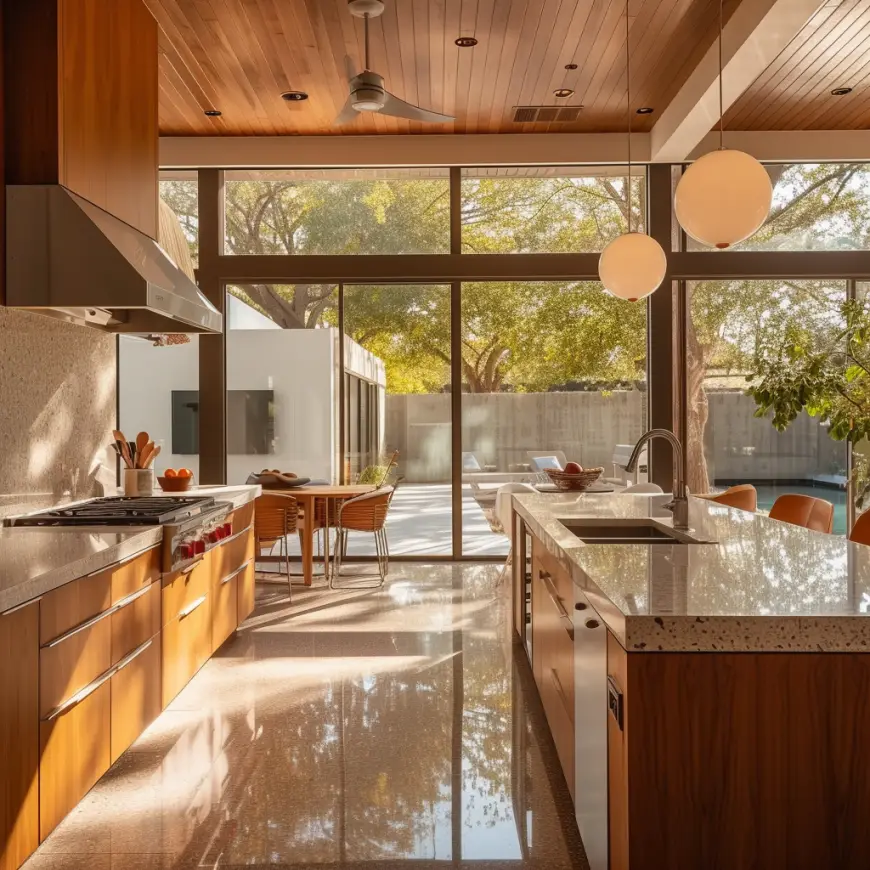
Effective Layouts for Different Kitchen Sizes
In smaller kitchens, the galley or L-shaped layouts are common, maximizing space and efficiency. In larger homes, open-plan layouts are often seen, with the kitchen flowing seamlessly into the living or dining areas. This openness is a hallmark of mid-century modern design, fostering a sense of community and interaction within the home.
Incorporating Mid-Century Elements into Modern Layouts
- Island Counters: Introducing an island counter can add a functional and aesthetic element to the kitchen, providing extra workspace and acting as a central gathering point.
- Built-In Appliances and Storage: To maintain clean lines and uncluttered surfaces, built-in appliances and cabinetry are ideal. They provide a sleek look while offering ample storage.
- Use of Pendant Lighting: Lighting is a critical aspect of mid-century design. Pendant lights, particularly those with geometric shapes or made of materials like glass or metal, can add a touch of elegance and character.
In summary, the ideal mid-century modern kitchen is one that balances aesthetic appeal with practical design. It’s a space that’s not just for cooking but also for living, reflecting the era’s emphasis on simplicity, functionality, and a connection with the world outside.
Notable Brands in Mid-Century Kitchen Design
Pioneering Brands of the Era
Mid-century modern kitchen design was not only shaped by its distinctive style but also by the brands that embraced and propelled this design movement. Several companies became synonymous with this era, known for their innovative designs, quality craftsmanship, and influence on contemporary kitchen aesthetics.
- Knoll: Famous for its furniture, Knoll played a significant role in bringing mid-century modern design into American homes. Their collaboration with designers like Eero Saarinen and Harry Bertoia resulted in iconic furniture pieces that complemented the minimalist and functional ethos of mid-century kitchens.
- Herman Miller: Another key player, Herman Miller, was instrumental in popularizing the mid-century modern style. The brand’s collaboration with designers like George Nelson and Charles and Ray Eames resulted in groundbreaking furniture designs that have become staples in mid-century styled interiors, including kitchens.
- Vitra: Although more known in Europe, Vitra contributed significantly to mid-century modern design by manufacturing and distributing works of prominent designers. Their products, characterized by simplicity and functionality, fit seamlessly into the mid-century kitchen aesthetic.
These brands, among others, not only provided functional elements for the kitchen but also ensured that each piece was a work of art, contributing to the overall beauty and cohesiveness of the space.
Real-Life Cases: Transforming Kitchens with Mid-Century Design
Case 1: Small Urban Apartment Kitchen Transformation
In a compact urban apartment, the challenge was to maximize space without compromising on style. The owners opted for a mid-century modern design to achieve this. The kitchen was outfitted with flat-panel cabinets in a teak finish, maintaining the clean lines and warmth characteristic of the era. A small, oval-shaped table with a white top and wooden legs was chosen to optimize dining space without cluttering the area. For the backsplash, white subway tiles were used to create a sense of openness and light. The final touch was a set of pendant lights with geometric shapes, adding a subtle yet distinct mid-century feel.
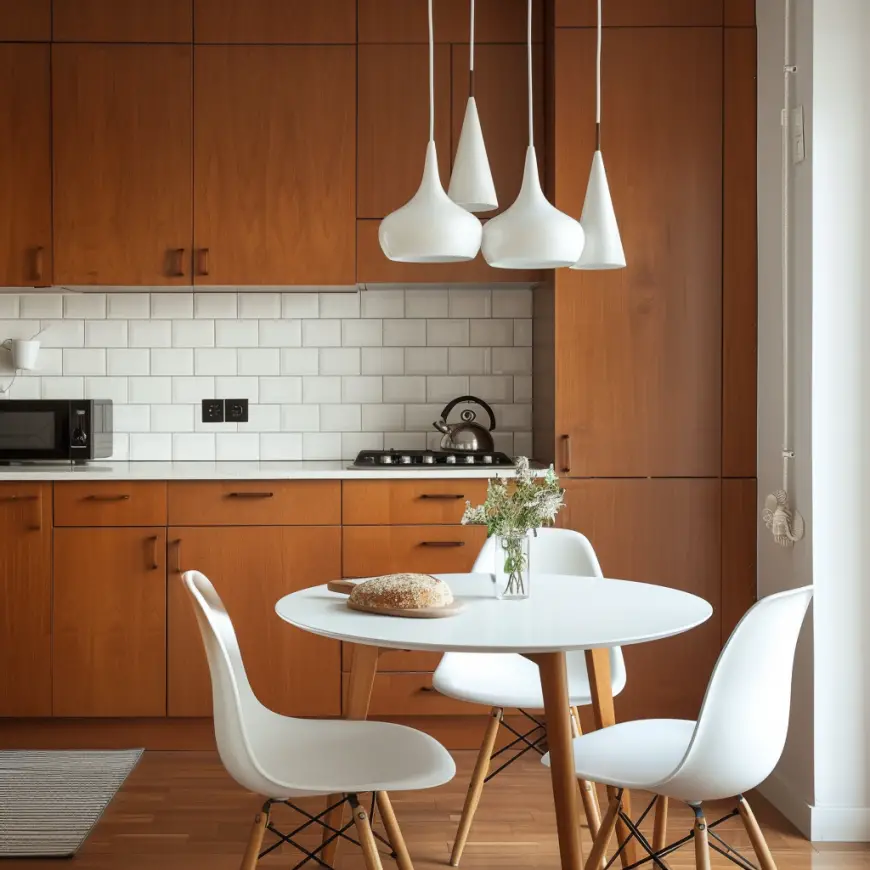
Case 2: Mid-Century Revival in a Suburban Home
A 1950s suburban home underwent a kitchen renovation to restore its original mid-century charm while incorporating modern conveniences. The designers retained the original layout, emphasizing the open-plan design typical of the era. Cabinetry was updated with walnut wood, and hardware was minimized to enhance the clean look. A bold color palette featuring mustard yellow and teal was chosen for the cabinetry and accent walls, respectively, staying true to the vibrant colors popular in mid-century design. Period-appropriate appliances were selected to add authenticity, while modern features like soft-close drawers and energy-efficient lighting were integrated seamlessly.

Case 3: Integrating Contemporary Elements in a Traditional Kitchen
This case involved a traditional kitchen in a mid-century modern house being updated to reflect the home’s architectural style. The challenge was to blend contemporary functionality with mid-century aesthetics. The solution was a mix of natural wood and white cabinets, with the wood bringing warmth and the white offering a modern, clean look. The original hardwood floors were restored to maintain the house’s character. For the countertops, quartz was used to provide a contemporary edge, complemented by a minimalist backsplash with subtle texture. The kitchen was completed with classic mid-century furniture pieces, including a round table and chairs with clean lines and organic forms.
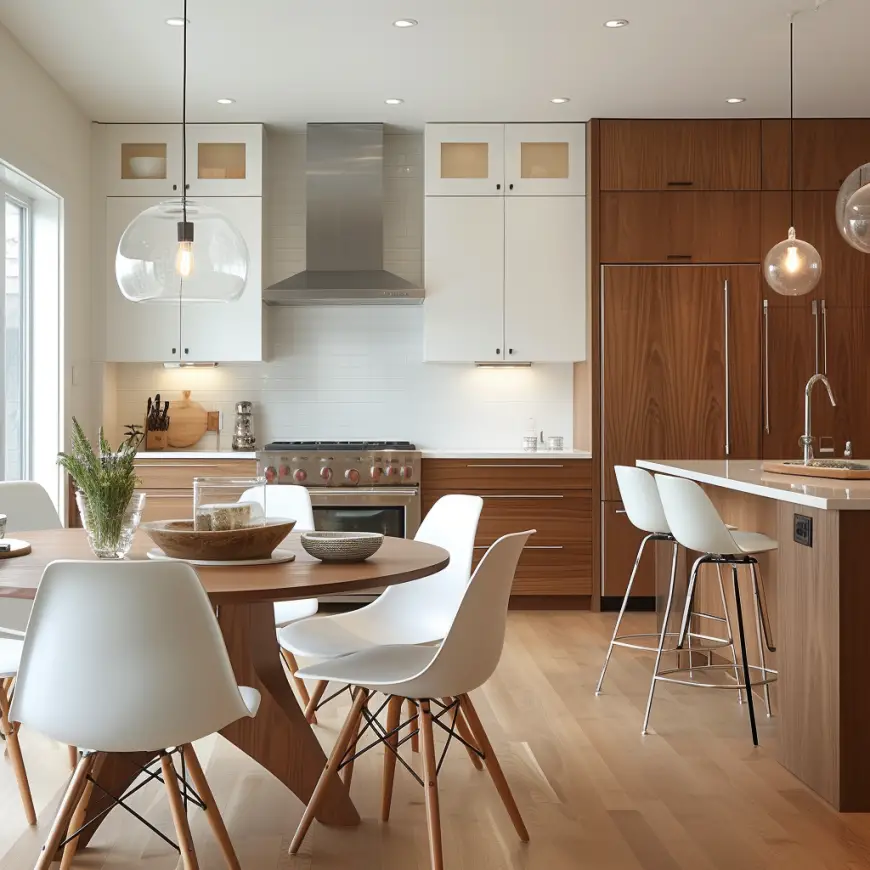
These real-life cases illustrate the versatility and timelessness of mid-century modern design in kitchen renovations. Whether in small apartments or larger homes, this style offers a blend of functionality, simplicity, and aesthetic appeal, making it a popular choice for homeowners looking to infuse their spaces with a classic yet contemporary vibe.
FAQs
What defines a mid-century modern kitchen?
A mid-century modern kitchen is characterized by its clean lines, minimalist layout, functionality, and use of bold colors and a mix of natural and man-made materials. It often features flat-panel cabinetry, vibrant color palettes, and a blend of wood, metal, and glass elements.
Can I incorporate mid-century design in a small kitchen?
Absolutely! Mid-century modern design is well-suited for small spaces due to its emphasis on functionality and minimalism. Opt for sleek cabinetry, open shelving, and compact furniture to make the most of the available space.
Are there specific color schemes for mid-century kitchens?
Mid-century kitchens often feature bold and vibrant colors like teal, mustard yellow, and avocado green, paired with natural wood tones. However, the style is versatile, and modern interpretations can include a range of color palettes.
What type of materials should I use for a mid-century kitchen?
Popular materials include wood (like teak and walnut), laminate for countertops, and metals for hardware and accents. These materials reflect the era’s innovation and contribute to the style’s distinct aesthetic
How do I modernize a mid-century kitchen without losing its charm?
To modernize a mid-century kitchen, incorporate contemporary appliances and materials like quartz countertops while retaining key elements like flat-panel cabinetry and vintage furniture. This blend maintains the charm while updating the functionality.

